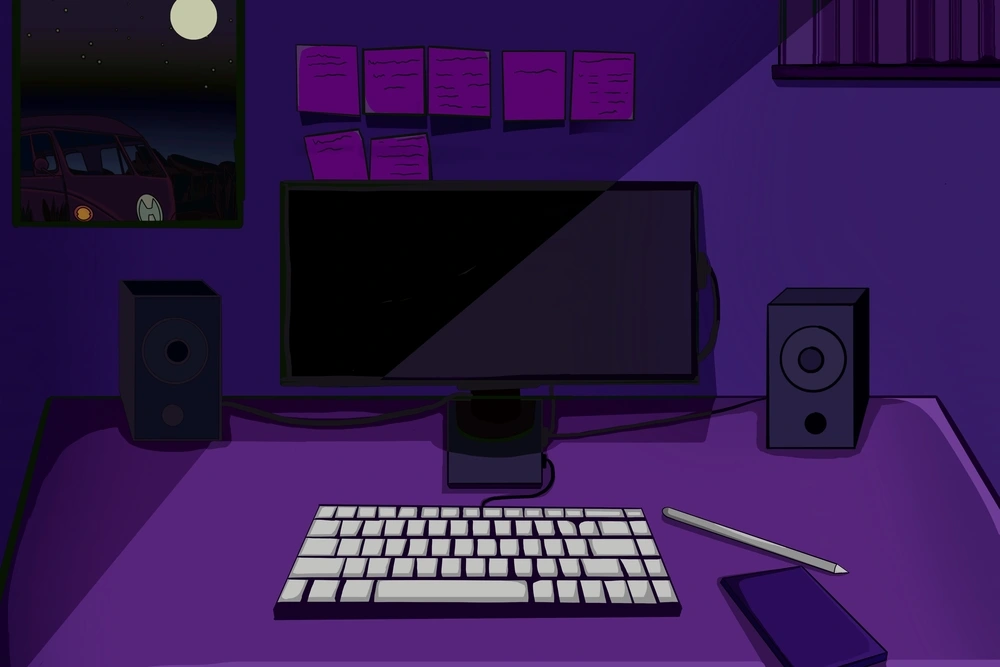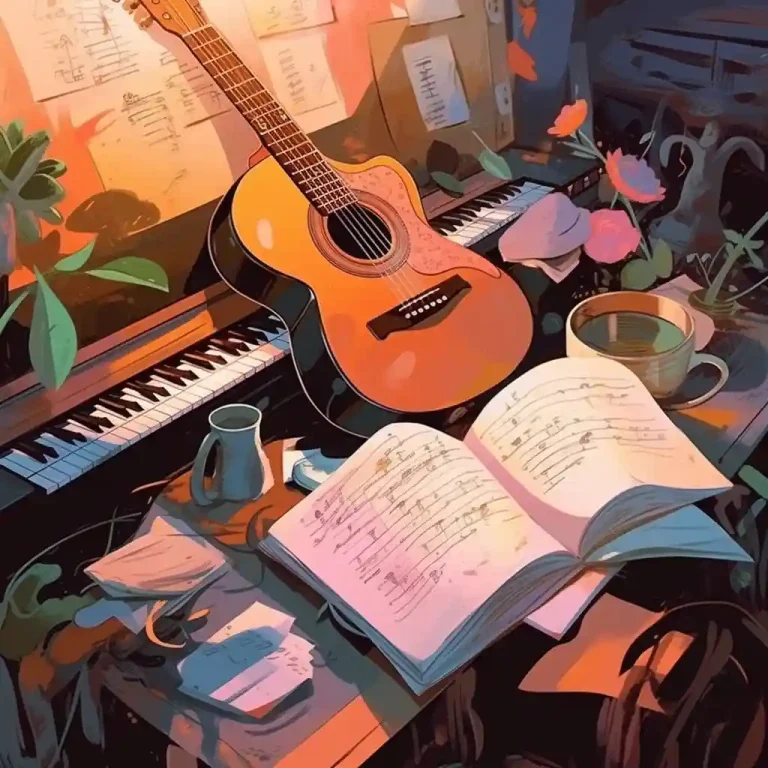What are Some Common Lofi Chords Used in Music Production?
Lofi music production has gained significant popularity recently, with its signature nostalgic and warm sound. A crucial component of that sound lies in the chord progressions used by producers. Look no further if you’re curious about the common lofi chords and their applications.
Chord progressions in lofi music often have jazzier influences, incorporating extended chords beyond basic triads, such as seventh, ninth, and even eleventh chords. This adds a layer of complexity and a distinct feel to the music.
Don’t worry, though; it’s easier to understand than you might initially think.
For example, a major 7th chord adds that smooth, jazz-like quality, which is an essential element in crafting lofi beats.
On the other hand, an ii-V-I progression with added seventh and ninth intervals brings extra flavor to the mix. Let’s dive deeper into the world of lofi chords and see what you can do with them in your music production.
Key Takeaways:
- Lofi music production often uses jazzier chord progressions and extended chords.
- Major 7th chords provide that smooth, vintage lofi beat.
- ii-V-I progressions with additional seventh and ninth intervals create a unique lofi sound.
Table of Contents
Understanding Lofi Music
Low Fidelity Sound
In the world of music production, lo-fi (short for low fidelity) music is an aesthetic that embraces imperfections, warmth, and nostalgia. Lo-fi sound is often characterized by tape saturation, giving the audio, subtle saturation, compression, and phasing1.
Nostalgic Elements
In addition to its distinctive sound quality, lo-fi music is known for its sentimental elements, which include slowed hip-hop beats and jazzy chords2. These elements evoke a sense of nostalgia, conjuring memories and emotions from days gone by.
Lofi Hip Hop
Within lo-fi music, the subgenre of lofi hip hop has gained particular traction, incorporating colorful chords with seventh and other extensions in its beats3. This style frequently features looping progressions and repetitious sampling, cultivating a soothing, atmospheric vibe that appeals to a broad audience4.
Influential Artists
As lo-fi music has evolved, several influential artists have emerged from the scene, some of the most notable include:
- Jinsang
- Potsu
- Nujabes5.
These artists have successfully merged nostalgic sonic qualities with modern production techniques, garnering widespread appreciation for their work.
Despite its simplicity, lo-fi music carries a unique, timeless charm that continues to captivate listeners around the world. With its low-fidelity sound, nostalgic elements, and distinctive samples, lo-fi music continues to thrive as both a genre and an important part of the broader music landscape.
Footnotes
The Role of Jazz in Lofi Music
Jazz has played a crucial role in the development of lofi music, especially when it comes to the chord structures and progressions used in the genre. In this section, we’ll discuss the influence of jazz chords and chord progressions in lofi music production.
Jazz Chords
Jazz chords are known for their rich and complex harmonies, which contribute to the nostalgic and emotive sound associated with lofi music. Many lofi tracks incorporate seventh chords and other chord extensions, such as 9th and 11th chords. Some common jazz chords used in lofi music include:
- Cmaj7
- Cmin7
- Cmin9
- Other 7th and 9th chords
These chords provide an intricate and warm sound that adds depth and character to lofi tracks. No matter what instrument you’re playing, these chords can help you create a fresh, jazzy foundation for your lofi music (source).
Chord Progressions
Lofi music often features distinctive and heartwarming chord progressions that contribute to the nostalgic atmosphere of the genre. Many of these progressions borrow from jazz, resulting in a fusion of styles that evokes feelings of comfort and familiarity.
As a lofi music producer, you can experiment with various jazz-inspired progressions to create a unique sound. Here are some popular lofi chord progressions:
- ii-V-I (2-5-1)
- I-vi-ii-V (1-6-2-5)
- vi-IV-iii-V (6-4-3-5)
Don’t be afraid to explore and combine different progressions to create a customized, innovative vibe for your lofi tracks [<a href=”https://blog.landr.com/lofi-chord-progressions/”>source</a>].
Ultimately, the key to successful lofi music production lies in your ability to blend elements of jazz, such as complex chords and creative progressions, with the relaxed, down-tempo beats that define the genre.
By incorporating jazz chords and progressions into your tracks, you’re not only paying homage to the roots of lofi music but also crafting a warm, inviting sound that will resonate with listeners.
Common Lofi Chords and Their Characteristics
Lofi music is known for its jazzy, nostalgic chords, which create a calming and soothing atmosphere. In this section, we’ll discuss some common lofi chords and their characteristics.
Major Chords
Major chords are generally upbeat and convey a happy, uplifting vibe. In lofi music, their presence adds warmth and adds a sense of comfort. Some examples of major chords you might encounter in lofi music:
- C major
- F major
- G major
Major chords can act as a foundation for more complex chord progressions, creating an inviting base for your lofi tracks.
Minor Chords
Contrasting the major chords, minor chords add a sense of melancholy and introspection to your lofi music. They help in creating a more emotionally evocative atmosphere. Commonly used minor chords in lofi music include:
- A minor
- D minor
- E minor
Experimenting with minor chords can lead to a deep, reflective vibe that resonates with listeners who appreciate the nostalgic nature of lofi music.
Maj7 Chords
Maj7 chords, or major seventh chords, add a jazzy, sophisticated touch to your lofi music. These chords are essentially major chords with an added major seventh note, which results in a smooth, soulful sound. For example:
- Cmaj7
- Fmaj7
- Gmaj7
Maj7 chords are particularly popular in lofi hip hop, chill hop, and jazz hop, where they contribute to the genre’s colorful and expressive chords (source).
M7 Chords
M7 chords, or minor seventh chords, combine the sadness of minor chords with the sophistication of Maj7 chords. These chords are particularly suitable for creating an introspective, laid-back atmosphere. Some examples of M7 chords are:
- Am7
- Dm7
- Em7
Incorporating M7 chords into your lofi music can further enhance its emotional depth and add a sense of complexity to your chord progressions.
Quick recap:
- Major chords create uplifting, warm vibes.
- Minor chords evoke melancholy and introspection.
- Maj7 chords contribute to the jazzy, expressive nature of lofi music.
- M7 chords add emotional depth and complexity.
As you produce your lofi music, remember to experiment with combinations of these chords to create a unique, nostalgic atmosphere that resonates with your audience.
Extended and Dominant Chords in Lofi
Lofi music is known for its dreamy, nostalgic sounds that transport listeners to a different world. One of the key elements that contribute to this unique atmosphere is the use of extended and dominant chords.
Let’s explore some common chords within this realm and how they’re used to create that signature Lofi sound.
Cmaj9
The Cmaj9 chord is an extended chord that adds a beautiful, jazzy touch to Lofi music. To create this chord, simply play a C major chord but add the 9th note from the major scale, which is D. This subtle addition provides a lush, sophisticated sound that perfectly encapsulates the Lofi vibe. Using the Cmaj9 chord can inject a sense of warmth and depth to your music, making it feel more inviting and relaxing.
Fmaj7
Like the Cmaj9, the Fmaj7 is an extended chord that adds a layer of complexity to your Lofi progressions. This chord consists of an F major chord with the 7th note of the major scale (E) added. The Fmaj7 creates a smooth, laid-back atmosphere that is a staple in many Lofi tracks. Incorporating this chord into your music evokes a calming, introspective mood that resonates with listeners.
Gmaj7
Another gem in the extended chord family, the Gmaj7 chord, is comprised of G major with the addition of the 7th note in the major scale (F#). Like the previous chords mentioned, Gmaj7 adds a rich, silky texture to your Lofi compositions. Implementing this chord as part of your progressions lends an air of sophistication and provides soothing, mellow ambiance listeners will be drawn into.
Minor Seventh Chords
Minor seventh chords play a vital role in Lofi music, offering a slightly darker and more emotional tone. These chords consist of a minor triad with an added seventh note from the natural minor scale. Some common examples include:
- Am7
- Bm7
- Cm7
- Dm7
The use of minor seventh chords brings a unique atmosphere to Lofi tracks, creating a sense of sadness or introspection while maintaining a relaxing ambiance. Experimenting with different combinations of these chords can help you find the perfect balance in your music.
Using extended and dominant chords, like Cmaj9, Fmaj7, Gmaj7, and various minor seventh chords, can elevate your Lofi music production to new heights. These chords add subtle yet powerful layers of emotion, unparalleled depth, and the unmistakable Lofi atmosphere listeners have come to love. So go on, incorporate these chords into your next Lofi masterpiece, and watch your music come to life in a truly special way.
Music Theory and Voicings
Tonic
The tonic is the foundation of any chord progression and is considered the “home” chord in the context of music theory. In lo-fi music production, the tonic chord is typically one from a major or minor key. For example, in the key of C major, the tonic chord would be C major, composed of the notes C, E, and G.
Knowing the tonic allows you to build chord progressions around it, creating a sense of resolution and familiarity within your lo-fi composition. Exploring different tonal centers can open up a new world of possibilities when it comes to chord progressions and the overall mood of your track.
Voicing Techniques
In music production, voicing refers to the way individual notes are arranged within a chord to create different textures and sonorities. Lo-fi music often utilizes jazzy chord voicings like 7th and 9th chords to introduce a nostalgic, warm feeling to the sound. Here’s a simple breakdown of some common voicings used in lo-fi music:
- Major 7: 1-3-5-7 (e.g., Cmaj7: C-E-G-B)
- Minor 7: 1-♭3-5-♭7 (e.g., Cm7: C-E♭-G-B♭)
- Dominant 7: 1-3-5-♭7 (e.g., C7: C-E-G-B♭)
- Minor 9: 1-♭3-5-♭7-9 (e.g., Cm9: C-E♭-G-B♭-D)
Practicing and mastering various voicing techniques can help you to build more complex and interesting chord progressions. It’s essential to experiment with different note arrangements to find the unique sound that works best for your lo-fi track.
Here are some tips for getting started with voicings:
-
Inversions: Try rearranging the order of notes within a chord. For instance, instead of playing C major in the root position (C-E-G), play it in the first inversion (E-G-C) or second inversion (G-C-E).
-
Chord extensions: Add extra notes to a basic chord like the 9th, 11th, and 13th to create more harmonic interest.
-
Spread voicings: Spread out the notes of a chord to create larger intervals and a more open sound. For example, instead of playing Cmaj7 (C-E-G-B), try playing it with a spread voicing like C-G-E-B.
Remember, the key to creating unique lo-fi chord progressions is experimentation, and these voicing techniques can help shape the overall mood and atmosphere of your track. So, don’t be afraid to delve deep into the world of music theory and explore new tonalities and chord voicings.
Ultimately, creating compelling lo-fi music production involves mastering the fundamentals of music theory, and knowing tonics and voicing techniques can give you a solid foundation to build your compositions.
So, take your time and practice applying these concepts, and you’ll be well on your way to crafting nostalgic, engaging, lo-fi tracks.
Lofi Music Production Elements
Lofi music is known for its unique blend of nostalgia, musical imperfections, and atmospheric sounds. In this section, we’ll explore some common elements of lofi music production, focusing on vinyl crackle and vocals.
Vinyl Crackle
A staple of the lofi sound is the use of vinyl crackle to create that warm, vintage feeling. Vinyl crackle can be described as the sound of a record playing on a turntable, with the characteristic hissing, pops, and crackling noises.
There are a few ways to add this element to your lofi production:
- Sample from actual vinyl records: Dig through your collection (or someone else’s) to find the perfect texture and warmth to layer over your track.
- Use a plugin: There are several plugins available that simulate vinyl crackle, allowing you to add it with ease and control the intensity.
- Online resources: Download a prerecorded vinyl crackle sample from various websites or online libraries.
Remember, subtlety is key; you don’t want the vinyl crackle to overpower your other elements.
Vocals
Vocals can play a significant role in lofi music, adding an emotive and human touch to your production. Here’s a list of tips on how to approach vocals in lofi music:
- Sample vocals: Look for old songs, movies, or speeches to sample vocals that evoke nostalgia and add depth to your track. Native Instruments suggests looking for sonic imperfections, such as misplayed notes and environmental noise, as these are considered deliberate choices in lofi music production.
- Chopped and pitched vocals: Experiment with chopping, rearranging, and pitch-shifting your vocal samples to create a unique and unexpected melody.
- Record your own: If you feel comfortable, record your own vocals or collaborate with a vocalist. Ensure that you process the vocals appropriately to complement the lofi aesthetic of your track.
Lofi music embraces imperfections and uses them to create a uniquely comforting and nostalgic atmosphere. By incorporating elements like vinyl crackle and thoughtfully chosen vocals, you can capture the essence of lofi and elevate your next music production.
Creating High-Quality Lofi Music
Creating high-quality lofi music is all about finding a balance between nostalgic, imperfect sounds and delivering a captivating listening experience. Let’s dive into some ways to make your music stand out.
Incorporating Chord Progressions in Production
When it comes to lofi music, chord progressions play a significant role in setting the mood and giving the music its distinctive sound. Here are a few common lofi chords you’ll encounter in production:
- Seventh chords (maj7, min7, and dom7)
- Ninth chords (maj9, min9)
- Suspended chords (sus2, sus4)
You can use these chords to create rich, jazzy, and nostalgic melodies. Experiment with combining different chord extensions and voicings to find the perfect progression for your track.
Incorporating chord progressions involves more than just choosing the right chords. You must also consider elements such as rhythm, tempo, and arrangement. Adding subtle variations to your chord patterns is essential to give your music depth and character while ensuring a smooth and immersive experience for the listener.
When working on your track, think about the following:
- Keep the tempo slow and steady, typically around 70-90 BPM.
- Use a laid-back drum groove to complement your chords.
- Add vinyl crackle, tape machine warble, or other imperfections to give the track a lofi feel1.
- Experiment with chopping and rearranging sampled chord progressions for added character.
- Create a sense of atmosphere and texture with ambient elements, like background noise or soft vocal samples.
| Chord Type | Example Chords |
|---|---|
| Seventh | Am7, Gmaj7, C7 |
| Ninth | Bbmaj9, F#min9 |
| Suspended | Csus2, Dsus4 |
Following these steps should help you create a captivating lofi track with engaging chord progressions and a memorable listening experience. Remember to use your intuition and explore new directions based on your musical vision!
Footnotes
Conclusion
In the world of Lofi music production, a few common chords stand out as favorites among producers. These chords often include seventh chords, extended chords, and colorful chord progressions that evoke a sense of nostalgia and emotion.
| Chords | Features | Examples |
|---|---|---|
| Seventh chords | Adds warmth and depth | Cmaj7, Gm7 |
| Extended chords | Create lush harmonies | Dmaj13, Fmin9 |
| Colorful chord progressions | Add emotional impact | Am7-Dm9-Gmaj7 |
Remember, Lofi music is all about the vibes and feelings it generates. As you explore these chords and progressions, trust your instincts and let your emotions guide your creativity.
Don’t be afraid to experiment with different chord combinations and production techniques.
You’re on the right track to mastering the art of Lofi music production. Keep honing your skills, learning from examples, and stay inspired.
Before you know it, you’ll be crafting your very own nostalgic Lofi masterpieces. Happy music-making!







